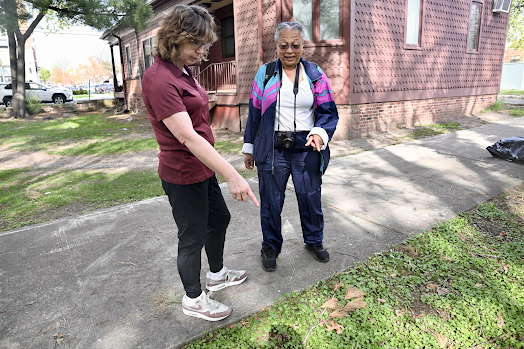Roughly 2 weeks ago, I cleaned one of the 4'x4' beds. We met as a group and planned a date to invite the Public School students. We started cleaning up the non biodegradables that folks toss in our Garden and noticed little patches like the photo below, minus the pretty yellow flower. I noticed that it was terribly difficult to remove the entire plant from the soil. It took nearly 2 hours to clear and turn the soil in this small bed. In that time, we generally clean 4 or 5 beds this size. We used Picture This to identify a plant that popped up in the freshly turned soil seemingly out of nowhere. After carefully examining the site, we realized that the plant had spread more in 24 hrs. than any plant I have ever seen. By the time, we had correctly identified it the garden was covered. We have a massive chore ahead of us. We operate an organic vegetable and herb garden. Removing the noxious weed and growing our Summer crop is going to be a challenge. So if you see us out there struggling, come on out and give us a hand. At least give us a honk when you pass, and don't forget to stop at the cross walk. Children and old people are generally present.
Warning: Small, pale bulbs (called bulbils) form on the stems. They attach to your shoes, clothes, and equipment and spread to new locations. Bulbils are carried by flowing water to new areas. This is only one of the many ways the weed spreads. Mowing, weed whacking, blowing, and raking also spreads it increasing the invasion. Make sure your landscaper can recognize this pretty little invader. Review this information with your landscaper.
If we do nothing “Lesser celandine” spreads rapidly and takes over areas. It spreads easily to natural areas where it smothers native plants and degrades habitats contributing to flood hazard.
1.)
It is toxic to humans
and animals if eaten raw in large quantities. I could not find any information about the effects of eating if allergic. Researchers suggest that it causes liver damage. Keep
your dogs and cats away from it.
2.) The juice from its stems, leaves and roots are an irritation
to the skin, like poison ivy. It must be handled with gloves. It causes tiny
blisters and a burning feeling instead of an itch.
3.) The Plant must be removed completely, including the tiny bulbils at the root. Remove individual plants and small patches before you see flowers. Established patches require several years of effort and monitoring to control. Dig out individual plants and sift the soil. Remove all the stems, tubers, and root pieces. During the summer, the stems die and leave the soil surface bare and prone to erosion.
4.) Dispose of the plant
with care. It should not be placed in with the regular garden refuse. It must
not be composted.
a.) Put the bagged material into the trash. Or take it to alandfill for disposal.
b.) Do not put lesser celandine plant material in a home compost pile, green waste bin, recycling service, or the yard debris bins provided by the city. It could spread to new locations.
5.) Research suggests that the plants may be sprayed with a solution of vinegar and soapy water or vinegar and salt. Amazon sells a solution premixed that promises to kill to the root. Regular table vinegar is only 5% acidic. A higher acidic content is needed.
6.) It is also suggested that it may be smothered out with
plastic by covering it completely for a long period of time and that clear
plastic allows the sun to burn it out. We are testing that theory at the
Garden.
7.) City Officials and the Rutgers Cooperative Extension must confer on the issue of how to get rid of lesser celandine in the parks, on school grounds, vegetable gardens and wet swampy areas. Oregon State University’s Cooperative Extension had the most concise instructions on how to recognize and remove lesser celandine.
Lesser Celandine: An Aggressive Non-Native Spring Ephemeral - photodocumentary that demonstrates how lesser celandine crowds out various native plants. https://bygl.osu.edu/index.php/node/2110
Conservation at Home - Help Stop the Spread where you are - https://home.nps.gov/subjects/invasive/prevention-at-home.htm











